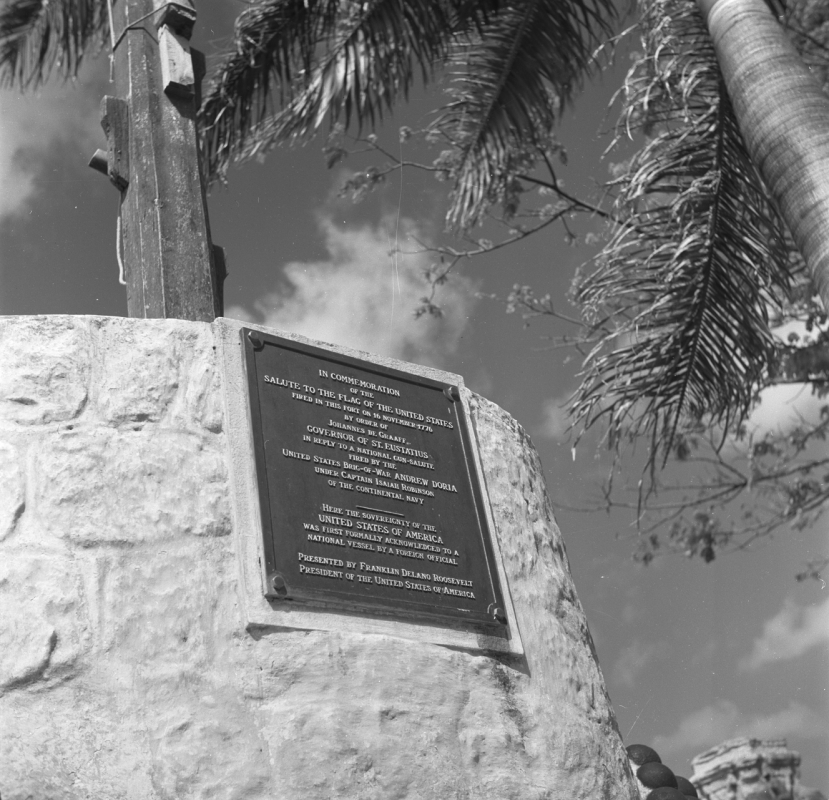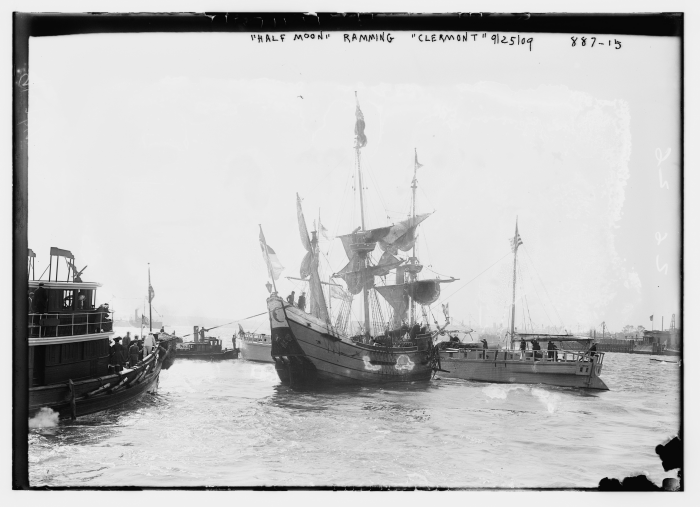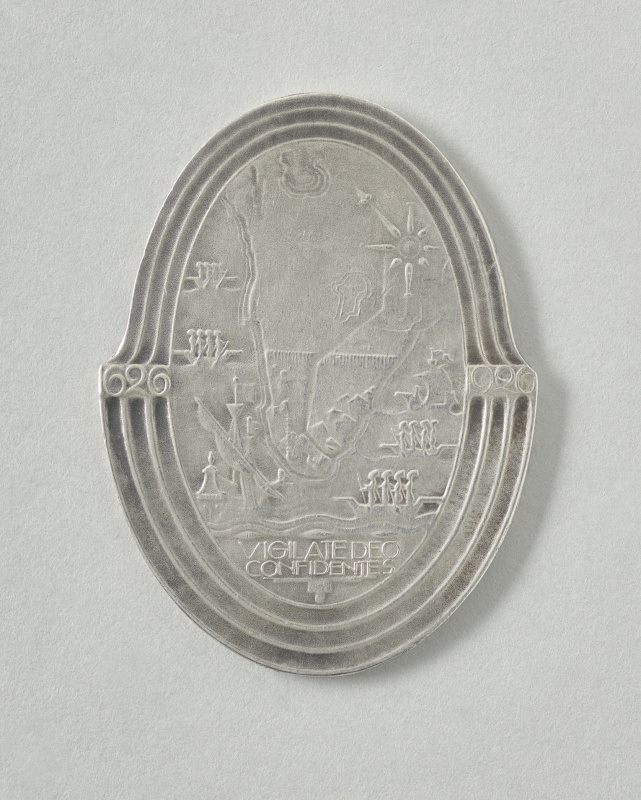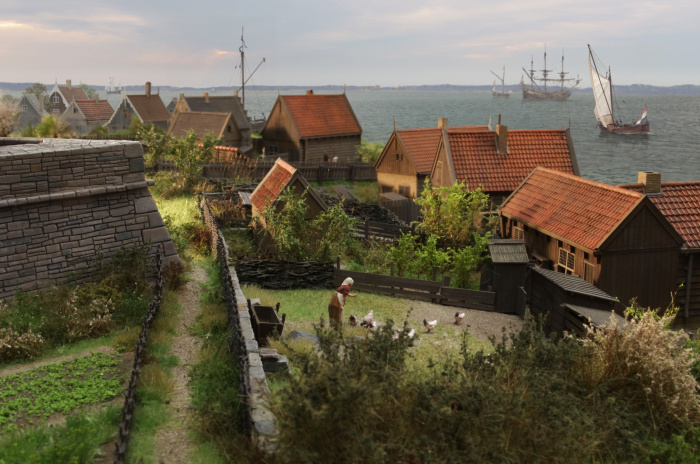When did it all begin?
Dutch-American Story #26
Written by Jaap Jacobs
It seems a simple enough question: when was New York founded? So when and how should we celebrate or commemorate it? As we come to the end of this blog series, Jaap Jacobs takes a look at previous commemorations of Dutch-American friendship. An exploration of what shaped these events leads to the question of how to commemorate New York’s Dutch history and Dutch-American friendship in 2024 and beyond.
On 16 November 1776, the brig Andrew Doria, flying an American flag, arrived at the roadsteads of the Dutch-held island St. Eustatius. The ship fired the customary gun salute and the guns of Fort Orange replied in like fashion. The ‘First Salute’ quickly came to be regarded as the first recognition by a foreign official of the independence of the rebellious American colonies, declared a few months earlier. It upset the British government, which was most seriously displeased and used the salute as an argument to issue a diplomatic protest to the Dutch Republic. Many years later, in 1939, to be exact, President Franklin Delano Roosevelt landed at St. Eustatius for a two-hour visit to unveil a commemorative plaque to mark the First Salute. 16 November was declared “Dutch-American Heritage Day” in 1990.
The First Salute was indeed a seminal moment. It kicked off a sequence of events, culminating in the Fourth Anglo-Dutch War (1780-1784), during which the Dutch States General first officially recognized John Adams as the first American envoy, subsequently signed a treaty with the rebellious colonies, and then sent an ambassador to America for the first time. In terms of establishing reciprocal diplomatic relations between sovereign countries, the First Salute is a valid starting point. Yet there are quite a few years and days suited to commemorate the relations between the Netherlands and the United States or those between the Dutch and New York, the two cornerstones of this blog series, leading up to another year of remembrance, 2024.

1609 and all that
A different starting point was selected when the U.S. Department of State issued a press release in April 2024 to wish His Majesty King Willem-Alexander a happy birthday and the people of the Netherlands a “Fijne Koningsdag”: 1609, when Henry Hudson sailed his ship Half Moon into what is now New York Bay. Rarely has an explorer lost his way in such a spectacular fashion as Hudson did in his search for a shortcut to spices. Wandering the northern seas and failing to find a passage to Asia east or west, his voyage did have one major if unintended result: it alerted Dutch merchants to a potentially rich fur trade, which set in motion Dutch colonization of the region, including the small outpost that eventually became New York City. 1609 is the most prominent of all the commemorable years. It was marked in 1809 by the publication of Washington Irving’s A History of New York from the Beginning of the World to the End of the Dutch Dynasty, the splendid spoof by Diedrich Knickerbocker, which created the enduring caricatural image of Dutch New York and its inhabitants. A century later the commemoration included honoring Robert Fulton for the first commercial application of steampower to navigate Hudson’s river and thus celebrated the quintessential nineteenth-century concept of progress. The Hudson-Fulton commemoration also spurred on numerous publications focusing on Dutch New York, as well as the building of replicas of Hudson’s Half Moon and Fulton’s Clermont. During the grand ships’ parade, the Half Moon rammed the Clermont. Although little damage was done, the incident provided an ironic collision over time, with 1609, 1809 and 1909 coming together. The entire commemoration amounted to an exuberant celebration of New York City as the world’s main metropole, with complete disregard for the deleterious effects of Dutch colonization on the Native Americans.

Hudson’s Year
Fast forward a century and 2009 provided the opportunity for a repeat. In the Netherlands the event was dubbed Henry Hudson 400, emphasizing the Amsterdam-New York connection, whereas New York State called it the Hudson-Fulton-Champlain Quadricentennial. The divergence in emphasis did not hamper the proliferation of commemorative events: exhibitions and publications, of course, but also a visit of another replica of the Half Moon and a Frisian festival on Governors Island. A constant current throughout the commemoration was the Dutch effort to promote all things Dutch, which included the gift of a “Dutch New Amsterdam Pavilion,” located on the Peter Minuit Plaza. Beautifully designed by Ben van Berkel and intended to serve as a location for providing New Yorkers and tourists with information about events in the Netherland as well as an outlet for beverages and snacks, it quickly fell out of use. It was refurbished in 2023 and now houses “Wafels & Dinges,” specializing in the ‘Liège wafel’, “the ‘other’ Belgian wafel, the one the Belgians kept secret from the world.” In 2009, the Native American presence in New Netherland, and on Manhattan in particular, received some attention, but it still did not do justice to their historical role.
This began to change in 2013. The year 1613 is important to New York immigrants from the Dominican Republic, who claim Juan Rodriguez as the very first immigrant. Rodriguez, a mulatto trader, arrived from the island of Dominica and stayed somewhere in the larger New York area. The records do not provide sufficient information as to his whereabouts and his brief sojourn was lost in time until the twentieth century, but that does not make his brief cameo less worthy of commemoration. That is also true of the Two Row Wampum, a shell-bead memento of an agreement between the Onondaga Nation, of the Haudenosaunee, and Dutch traders. The Two Row Wampum symbolizes the two nations travelling alongside each other in peace and friendship, called kashwenta. In 2013, the agreement was celebrated as the first treaty between two sovereign nations and thus as proof of the Onondaga claim to international recognition. In the summer of 2013, over two hundred canoe paddlers, indigenous as well as non-indigenous, travelled down the Hudson River to Manhattan to honor the event. There is indisputable evidence for the existence of kashwenta later in the seventeenth century, but unfortunately the connection with 1613 is doubtful. The so-called Tawagonshi Treaty, often proposed as corroboration, has been proven to be a twentieth-century fake and in 1613 Dutch traders on the Hudson River did not represent anything but their own mercantile interests.

Moving to Manhattan?
Yet much remains unknown about 1624, 1625, and indeed 1626. There are no documents extant for the crucial months after early 1625 and before September 1626. Nevertheless, in 1974 the city government of New York City decided that 1625 was a much better founding year than 1664, which acknowledged the English takeover rather than the Dutch origins. And of course, making that decision in 1974 meant that New York could age rapidly and celebrate its 350th anniversary only eleven years after celebrating its 300th.
Flash back to 1626 and the so-called ‘Schagen Letter’. The West India Company ‘purchased’ the island from its indigenous owners in 1626 and began building Fort Amsterdam. The news reached the States General in the Schagen Letter, which by now has made at least three trips to New York. Much has been said about this document, although it still warrants further research. Some people point to the large cargo of peltries of the ship that had just arrived in Amsterdam as additional evidence for the commercial motives for Dutch colonization. Yet that interpretation overlooks elements of the letter that are of crucial importance in terms of the legal justifications underpinning the Dutch claims on New Netherland. The legitimate purchase from rightful owners, at least according to European standards, is the main context of the letter. In light of the arguments that had surfaced in Anglo-Dutch exchanges in the preceding years, the references to children being born in New Netherland and corn having been sown and harvested should be interpreted as conclusive evidence of actual occupation of American soil by colonists sent out by a company holding a charter from the Dutch government.


Medal commemorating the ‘purchase’ of Manhattan in 1626 and the transfer of the Netherland Monument in Battery Park to the City of New York on St. Nicholas’ Day, 6 December 1926. After renovation the Netherland Monument was rededicated on 16 November 2000, Dutch-American Heritage Day. Text on the medal: “The purchase of Manhattan 1626 was the first step in the foundation of New York City.” Design: Hendrik Albertus van der Eijnde, 1926. Courtesy Dutch National Maritime Museum Amsterdam.
With the increasing criticism of European colonization, the Schagen letter has become a contested object, no longer universally venerated as the ‘birth certificate’ of New York City. In our days, it is imperative that Native Americans, as well as other stakeholders, are not excluded.
Beyond 1626
After 1626, New Amsterdam began to develop slowly and acquire the trappings of a colonial city. First arriving in August 1627, enslaved Africans contributed significantly to in building up and sustaining the Dutch colony. No commemoration can be complete without including the black presence in New Netherland. Surely, Sunday 27 August 2027 would be a good day for a commemoration of their arrival. And in 1628, the first cleric of New York arrived, Jonas Michaëlius, minister of the Dutch Reformed Church. The colonists would not have regarded their community complete without a man of the cloth. Plans are already being drawn up for a commemoration in 2028, in when both the Collegiate Reformed Protestant Dutch Church and the Reformed Church in America have their 400th anniversary.
Lastly, we have two events much later in the seventeenth century. First, 1653, the year in which New Amsterdam was granted city rights. For European cities, the grant of city status by a higher authority is usually considered the official founding. City rights comprised jurisdictional, economic, and military privileges, such as a separate court, staple rights, and defensive works, for instance walls. For the city’s community these powers were of particular importance and the documents containing the stipulations were among the best kept. In Europe, a charter of city rights is often a city’s earliest document still extant, with the earlier presence of concentrated habitation lost in time. For New Amsterdam, 1653 is certainly important as it established a municipal form of government, with its own court with restricted powers, which were gradually expanded subsequently. 1653 was commemorated in 2003 by a scholarly conference in Amsterdam, which, scholars being scholars, unsurprisingly resulted in a book publication. Second, for a long time the English presence in New York was considered more important that the Dutch. In the nineteenth century, 1686, when the city received a charter dividing the city into wards, was regarded as the most important year. In 1915, the year 1664 was adopted and included in the redesigned seal of New York, just in time for the city’s 250th anniversary. And decades later, in 1974, the founding year was changed to 1625.

The Moral Measure of the Past
When you ask an historian the simple question “When was New York founded?”, you get a complicated answer. From the historian’s perspective, all moments in history require unpacking, or, in the profession’s jargon, contextualization. Yet in order to connect with a wider audience, clarity is required and it often leads to simplification. There is a clear preference to select a single moment in time as seminal and, as the ever-earlier years for New York City’s founding show, the earlier, the better. Historians obviously do not have the final say in such matters, although their advice may carry some weight as there is a strong desire to find legitimation in historical scholarship. Historical truth still matters, even though it is not always nothing but the truth, nor indeed the whole truth.
‘Founding’ a city, in whatever way we define it, is of course not just a moment but an ongoing process. In selecting 1624 and dubbing it Future400 or NY400, 2024 becomes the starting point for a series of commemorative years. 1624 to 1628 covers a number of important firsts in New York’s history, highlighting the parts played by Native Americans, Africans and Europeans in laying the foundation for the great city of New York. In his thoughtful op-ed in the New York Times of 24 April 2024, Russell Shorto rightly states that we should celebrate, but he also raises the question how we should do that in an age in that tends to disregard the nuance and complexity of the past. His solution is to highlight achievements as well as failures. I could not agree more. Ultimately, the choice what and how to celebrate and commemorate needs to strike a balance between what happened in the past and what we need—or think we need—for the present and the future. As the overview of commemorations and celebrations shows that balance has over time always been a pendulum, subject to shifting sensibilities and sentiments. If the past teaches us anything, it is, in my opinion, that it is arrogant and haughty to presume that our current views are the ultimate and timeless benchmark for right and wrong. A nuanced and inclusive perspective is required to reveal the complexities of the past and imbue our commemorations with a sense of humility. Commemorations serve as a reminder that, like the people of the past, we too are subject to the eternal fallibilities of mankind and its propensity for unspeakable atrocities. Reflecting on the past may help us to sharpen our collective moral compass. Thus our commemorations and celebrations should stress our shared humanity and be as inclusive as possible, in 2024 and beyond.
About the blogseries
This is the twenty-sixth installment in a monthly series of blogs telling stories about the rich history shared by the American and the Dutch peoples. Authors from both countries present accounts of their own choosing, from a wide variety of perspectives, in order to give as full a picture as possible of the triumphs and heartbreaks, delights and disappointments that happened place over hundreds of years of shared history. Not all these stories are ‘feel-good history’, however. While the relations between the Dutch and the Americans have for the most part been stable and peaceful, their shared history contains darker moments as well. Acknowledging that errors have been made in the past does not diminish this friendship but, rather, deepens it.
Further Reading
- Harinck, George, and Hans Krabbendam (eds.), Amsterdam-New York. Transatlantic Relations and Urban Identities Since 1653 (Amsterdam: VU University Press, 2005).
- Hershkowitz, Leo, ‘Paul O’Dwyer and Changing New York History’, de Halve Maen 81 (2008), 79-81.
- Jacobs, Jaap, Op zoek naar Nederlands New York. Een historisch reisboek (Amsterdam: Boom, 2009).
- Johnson, Kathleen Eagen, The Hudson-Fulton Celebration: New York’s River Festival of 1909 and the Making of a Metropolis (New York: Fordham University Press, 2009).
- Shorto, Russell, ‘New York Is Turning 400. We Should Celebrate. But How?’ The New York Times, 24 April 2024.
- Tuchman, Barbara, The First Salute: A View of the American Revolution (New York: Knopf, Random House, 1988).
- https://www.nycgovparks.org/parks/battery-park/monuments/1092
- https://indiancountrytodaymedianetwork.com/2013/10/06/haudenosaunee-renew-two-row-wampum-dutch
- https://www.dutchcultureusa.com/future400/
Illustrations
- The plaque commemorating the first salute. Photo Willem van den Poll, 1947. National Archives of the Netherlands, coll. 2.24.14.02, inv. nr. 252-8305.https://www.nationaalarchief.nl/onderzoeken/fotocollectie/aebf0a8e-d0b4-102d-bcf8-003048976d84
- The Halve Maen ramming the Clermont, 25 September 2009. Library of Congres, Bain News Service photograph collection (DLC) 2005682517.https://lccn.loc.gov/2014684268
- Dutch Consul General Rob de Vos, Haudenosaunee leaders Jake Edwards, Oren Lyons, and Hickory Edwards, and Andy Mager renew the Two Row Treaty. Author: Andy Mager/Charlotte Loganhttps://en.wikipedia.org/wiki/File:Dutch_UN_Consul_and_Haudenosaunee_Leaders_renew_Two_Row_Treaty.jpgt.jpg
- Harbor Day on Governors Island, 13 September 2009, with numerous Dutch ships. Photo Jaap Jacobs.
- Medal commemorating the ‘purchase’ of Manhattan in 1626 and the transfer of the Netherland Monument in Battery Park to the City of New York on St. Nicholas’ Day, 6 December 1926. After renovation the Netherland Monument was rededicated on 16 November 2000, Dutch-American Heritage Day. Text on the medal: “The purchase of Manhattan 1626 was the first step in the foundation of New York City.” Design: Hendrik Albertus van der Eijnde, 1926. Courtesy Dutch National Maritime Museum Amsterdam.
- In 2024 commemorations include the building of a scale model of New Amsterdam in ca. 1660. Courtesy New Holland Foundation/Artitec.
.




